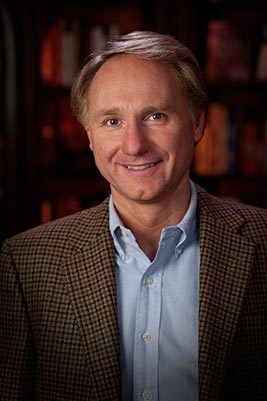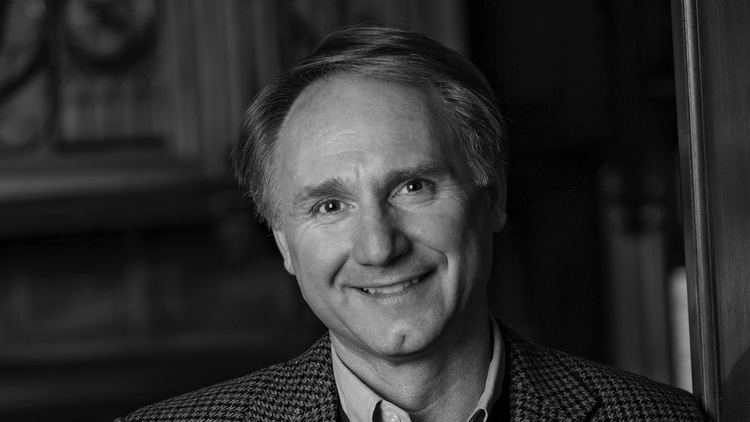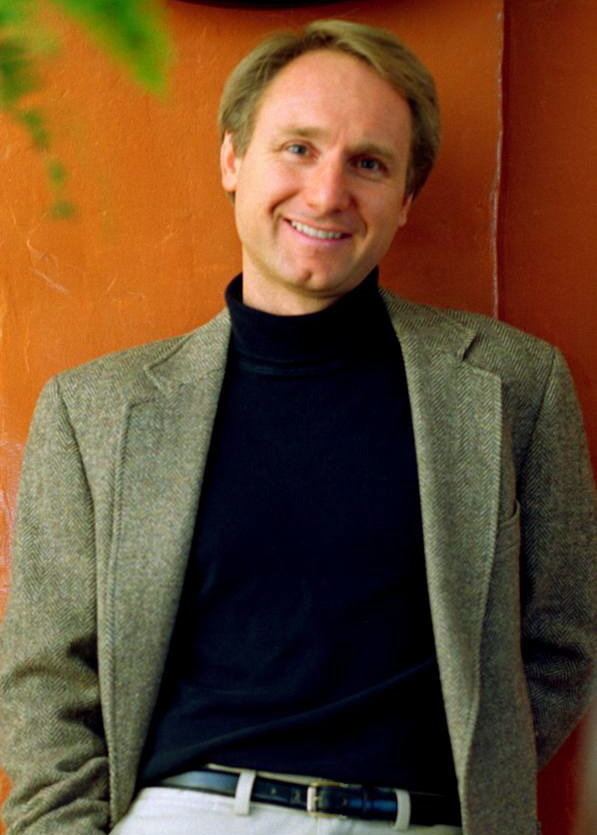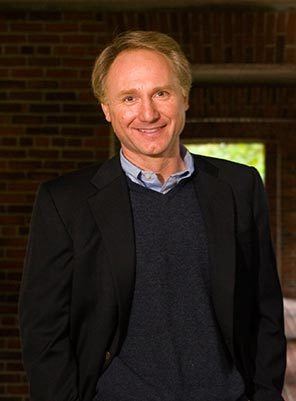Occupation Novelist Name Dan Brown Language Spanish and English Role Author · danbrown.com | Nationality American Spouse Blythe Brown (m. 1997) | |
 | ||
Genre Thriller, adventure, mystery, conspiracy Notable works Digital FortressDeception PointAngels & DemonsThe Da Vinci CodeThe Lost SymbolInferno Movies The Da Vinci Code, Angels & Demons, The Lost Symbol Awards Book Sense Book of the Year Award for Adult Fiction, Goodreads Choice Awards Best Mystery & Thriller Books The Da Vinci Code, Inferno, Angels & Demons, The Lost Symbol, Digital Fortress Similar People Leonardo da Vinci, Tom Hanks, Ron Howard, John Grisham, Ken Follett Profiles | ||
Will science kill God? - Dan Brown, Author of 'The Da Vinci Code'
"Origin" author Dan Brown on reconciling God and artificial intelligence
Daniel Gerhard "Dan" Brown (born June 22, 1964) is an American author of thriller fiction, most notably the novels Angels & Demons (2000), The Da Vinci Code (2003), and Inferno (2013). Brown's novels are treasure hunts set in a 24-hour period, and feature the recurring themes of cryptography, keys, symbols, codes, and conspiracy theories. His books have been translated into 52 languages, and as of 2012, sold over 200 million copies. Three of them, Angels & Demons (2000), The Da Vinci Code (2003), and Inferno (2013), have been adapted into films.
Contents
- Will science kill God Dan Brown Author of The Da Vinci Code
- Origin author Dan Brown on reconciling God and artificial intelligence
- Early life
- Songwriter and pop singer
- Writing career
- Influences and habits
- Adaptations
- Copyright infringement cases
- Charity work
- Reception
- References

Brown's novels that feature the lead character Robert Langdon also include historical themes and Christianity as motifs, and as a result, have generated controversy. Brown states on his website that his books are not anti-Christian, though he is on a 'constant spiritual journey' himself, and says that his book The Da Vinci Code is simply "an entertaining story that promotes spiritual discussion and debate" and suggests that the book may be used "as a positive catalyst for introspection and exploration of our faith".

Early life

Dan Gerhard Brown was born on June 22, 1964 at Exeter Hospital. He has a younger sister, Valerie (born 1968) and brother, Gregory (born 1975). They were raised in Exeter, New Hampshire, where Brown attended Exeter's public schools until the ninth grade. He grew up on the campus of Phillips Exeter Academy, where his father, Richard G. Brown, was a teacher of mathematics and wrote textbooks from 1968 until his retirement in 1997. his mother, Constance (née Gerhard), trained as a church organist and student of sacred music. Brown was raised an Episcopalian, and described his religious evolution in a 2009 interview:
"I was raised Episcopalian, and I was very religious as a kid. Then, in eighth or ninth grade, I studied astronomy, cosmology, and the origins of the universe. I remember saying to a minister, 'I don't get it. I read a book that said there was an explosion known as the Big Bang, but here it says God created heaven and Earth and the animals in seven days. Which is right?' Unfortunately, the response I got was, 'Nice boys don't ask that question.' A light went off, and I said, 'The Bible doesn't make sense. Science makes much more sense to me.' And I just gravitated away from religion.

When asked in the same interview about his then-current religious views, Brown replied:

The irony is that I've really come full circle. The more science I studied, the more I saw that physics becomes metaphysics and numbers become imaginary numbers. The farther you go into science, the mushier the ground gets. You start to say, 'Oh, there is an order and a spiritual aspect to science.'"

Brown's interest in secrets and puzzles stems from their presence in his household as a child, where codes and ciphers were the linchpin tying together the mathematics, music, and languages in which his parents worked. The young Brown spent hours working out anagrams and crossword puzzles, and he and his siblings participated in elaborate treasure hunts devised by their father on birthdays and holidays. On Christmas, for example, Brown and his siblings did not find gifts under the tree, but followed a treasure map with codes and clues throughout their house and even around town to find the gifts. Brown's relationship with his father inspired that of Sophie Neveu and Jacques Saunière in The Da Vinci Code, and Chapter 23 of that novel was inspired by one of his childhood treasure hunts.

After graduating from Phillips Exeter, Brown attended Amherst College, where he was a member of Psi Upsilon fraternity. He played squash, sang in the Amherst Glee Club, and was a writing student of visiting novelist Alan Lelchuk. Brown spent the 1985 school year abroad in Seville, Spain, where he was enrolled in an art history course at the University of Seville. Brown graduated from Amherst in 1986.
Songwriter and pop singer

After graduating from Amherst, Brown dabbled with a musical career, creating effects with a synthesizer, and self-producing a children's cassette entitled SynthAnimals, which included a collection of tracks such as "Happy Frogs" and "Suzuki Elephants"; it sold a few hundred copies. He then formed his own record company called Dalliance, and in 1990 self-published a CD entitled Perspective, targeted to the adult market, which also sold a few hundred copies. In 1991 he moved to Hollywood to pursue a career as singer-songwriter and pianist. To support himself, he taught classes at Beverly Hills Preparatory School.
He also joined the National Academy of Songwriters, and participated in many of its events. It was there that he met Blythe Newlon, a woman 12 years his senior, who was the Academy's Director of Artist Development. Though it was not officially part of her job, she took on the seemingly unusual task of helping to promote Brown's projects; she wrote press releases, set up promotional events, and put him in contact with people who could be helpful to his career. She and Brown also developed a personal relationship, though this was not known to all of their associates until 1993, when Brown moved back to New Hampshire, and it was learned that Newlon would accompany him. They married in 1997, at Pea Porridge Pond, near Conway, New Hampshire.
In 1994 Brown released a CD titled Angels & Demons. Its artwork was the same ambigram by artist John Langdon which he later used for the novel Angels & Demons. The liner notes also again credited his wife for her involvement, thanking her "for being my tireless cowriter, coproducer, second engineer, significant other, and therapist". The CD included songs such as "Here in These Fields" and the religious ballad, "All I Believe". Brown and his wife, Blythe, moved to his home town in New Hampshire in 1993. Brown became an English teacher at his alma mater Phillips Exeter, and gave Spanish classes to 6th, 7th, and 8th graders at Lincoln Akerman School, a small school for K–8th grade with about 250 students, in Hampton Falls.
Writing career
While on vacation in Tahiti in 1993, Brown read Sidney Sheldon's novel The Doomsday Conspiracy, and was inspired to become a writer of thrillers. He started work on Digital Fortress, setting much of it in Seville, where he had studied in 1985. He also co-wrote a humor book with his wife, 187 Men to Avoid: A Survival Guide for the Romantically Frustrated Woman, under the pseudonym "Danielle Brown". The book's author profile reads, "Danielle Brown currently lives in New England: teaching school, writing books, and avoiding men." The copyright is attributed to Dan Brown.
In 1996 Brown quit teaching to become a full-time writer. Digital Fortress was published in 1998. His wife, Blythe, did much of the book's promotion, writing press releases, booking Brown on talk shows, and setting up press interviews. A few months later, Brown and his wife released The Bald Book, another humor book. It was officially credited to his wife, though a representative of the publisher said that it was primarily written by Brown. Brown subsequently wrote Angels & Demons and Deception Point, released in 2000 and 2001 respectively, the former of which was the first to feature the lead character, Harvard symbology expert Robert Langdon.
Brown's first three novels had little success, with fewer than 10,000 copies in each of their first printings. His fourth novel, The Da Vinci Code, became a bestseller, going to the top of the New York Times Best Seller list during its first week of release in 2003. It is one of the most popular books of all time, with 81 million copies sold worldwide as of 2009. Its success has helped push sales of Brown's earlier books. In 2004 all four of his novels were on the New York Times list in the same week, and in 2005 he made Time magazine's list of the 100 most influential people of the year. Forbes magazine placed Brown at No. 12 on their 2005 "Celebrity 100" list, and estimated his annual income at US$76.5 million. The Times estimated his income from Da Vinci Code sales as $250 million.
Brown's third novel featuring Robert Langdon, The Lost Symbol, was released on September 15, 2009. According to the publisher, on its first day the book sold over one million in hardcover and e-book versions in the US, the UK and Canada, prompting the printing of 600,000 hardcover copies in addition to the five million first printing. The story takes place in Washington D.C. over a period of 12 hours, and features the Freemasons. Brown's promotional website states that puzzles hidden in the book jacket of The Da Vinci Code, including two references to the Kryptos sculpture at CIA Headquarters in Langley, Virginia, give hints about the sequel. This repeats a theme from some of Brown's earlier work.
Brown's fourth novel featuring Robert Langdon, Inferno is a mystery thriller novel released on May 14, 2013, by Doubleday. It immediately became a bestseller.
In a 2006 interview, Brown stated that he had ideas for about 12 future books featuring Robert Langdon.
Characters in Brown's books are often named after real people in his life. Robert Langdon is named after John Langdon, the artist who created the ambigrams used for the Angels & Demons CD and novel. Camerlengo Carlo Ventresca is named after On a Claire Day cartoonist friend Carla Ventresca. In the Vatican archives, Langdon recalls a wedding of two people named Dick and Connie, which are the names of his parents. Robert Langdon's editor Jonas Faukman is named after Brown's real life editor Jason Kaufman. Brown also said that characters were based on a New Hampshire librarian, and a French teacher at Exeter, André Vernet. Cardinal Aldo Baggia, in Angels & Demons, is named after Aldo Baggia, instructor of modern languages at Phillips Exeter Academy.
In interviews, Brown has said his wife, Blythe, is an art historian and painter. When they met, she was the Director of Artistic Development at the National Academy for Songwriters in Los Angeles. During the 2006 lawsuit over alleged copyright infringement in The Da Vinci Code, information was introduced at trial that showed that Blythe did research for the book. In one article, she was described as "chief researcher".
In late 2016, Brown has revealed that Doubleday will publish his next book, Origin on September 27, 2017. It is his seventh book published overall, and the fifth book in his Robert Langdon series.
Influences and habits
In addition to Sidney Sheldon, Brown has been quite vocal about a number of other literary influences who have inspired his writing. He has named his six favorite literary works as Gödel, Escher, Bach by Douglas Hofstadter, Codes Ciphers & Other Cryptic & Clandestine Communication by Fred Wrixon, Of Mice and Men by John Steinbeck, Wordplay: Ambigrams and Reflections on the Art of Ambigrams by John Langdon, Shakespeare's Much Ado About Nothing and The Puzzle Palace by James Bamford. Commenting on Much Ado About Nothing, Brown says, "I didn't understand how funny this play Much Ado About Nothing truly was until I became an English teacher and had to teach it. There is no wittier dialogue anywhere." Speaking of Robert Ludlum's The Bourne Trilogy, he states, "Ludlum's early books are complex, smart, and yet still move at a lightning pace. This series got me interested in the genre of big-concept, international thrillers." His other favorite books include Kane and Abel by Jeffrey Archer, Plum Island by Nelson DeMille and The Elements of Style by Strunk and White. Recurring elements that Brown prefers to incorporate into his novels include a simple hero pulled out of their familiar setting and thrust into a new one with which they are unfamiliar, strong female characters, travel to interesting locations, and a 24-hour time frame in which the story takes place.
Because of the research-intensive nature of his novels, Brown can spend up to two years writing them. To remain focused on such projects, Brown ensures that when he chooses a theme for the novel (what he refers to as the "big idea"), and its subject, that they be those that can hold his interest. In Brown's view, the ideal topic does not have an easily defined right or wrong view, but presents a moral grey area that can lend itself to debate. Because his favorite subjects include codes, puzzles, treasure hunts, secretive organizations and academic lectures on obscure topics, he tends to incorporate those into his novels. Because Brown considers writing to be a discipline that requires constant practice, he has developed a routine to maintain his abilities. He wakes up at 4:00 am when there are no distractions (a practice he began with Digital Fortress when he had two daytime teaching jobs) and when he feels most productive, in order to give symbolic importance to the first order of business each day. He keeps an antique hourglass on his desk, so that he can stop briefly every hour to do push-ups, sit-ups and stretching exercises to keep his blood flowing. Brown does his writing in his loft. He has also told fans that he uses inversion therapy to help with writer's block. He uses gravity boots and says, "hanging upside down seems to help me solve plot challenges by shifting my entire perspective".
Adaptations
In 2006 Brown's novel The Da Vinci Code was released as a film by Columbia Pictures, with director Ron Howard. It was widely anticipated and launched the 2006 Cannes Film Festival, though it received overall poor reviews. It currently has a 24% rating at the film review aggregator website Rotten Tomatoes, derived from 165 negative reviews of the 214 counted. It was later listed as one of the worst films of 2006 on Ebert & Roeper, but also the second highest-grossing film of the year, pulling in US$750 million worldwide. Brown was listed as one of the executive producers of the film The Da Vinci Code, and also created additional codes for the film. One of his songs, "Phiano", which Brown wrote and performed, was listed as part of the film's soundtrack. In the film, Brown and his wife can be seen in the background of one of the early book signing scenes.
The next film, Angels & Demons, was released on May 15, 2009, with Howard and Hanks returning. It, too, garnered mostly negative reviews, though critics were kinder to it than to its predecessor. As of July 2013, it has a 37% meta-rating at Rotten Tomatoes.
Filmmakers expressed interest in adapting The Lost Symbol into a film as well. The screenplay was being written by Danny Strong, with pre-production expected to begin in 2013. According to a January 2013 article in Los Angeles Times the final draft of the screenplay was due sometime in February, but in July 2013, Sony Pictures announced they would instead adapt Inferno for an October 14, 2016 release date with Ron Howard as director, David Koepp adapting the screenplay and Tom Hanks reprising his role as Robert Langdon.
Imagine Entertainment is set to produce a television series based on Digital Fortress, to be written by Josh Goldin and Rachel Abramowitz.
Copyright infringement cases
In August 2005 author Lewis Perdue unsuccessfully sued Brown for plagiarism, on the basis of claimed similarity between The Da Vinci Code and his novels, The Da Vinci Legacy (1983) and Daughter of God (2000). Judge George Daniels said, in part: "A reasonable average lay observer would not conclude that The Da Vinci Code is substantially similar to Daughter of God."
In April 2006 Brown's publisher, Random House, won a copyright infringement case brought by authors Michael Baigent and Richard Leigh, who claimed that Brown stole ideas from their 1982 book Holy Blood Holy Grail for his 2003 novel The Da Vinci Code. It was in the book Holy Blood Holy Grail that Baigent, Leigh, and co-author Henry Lincoln had advanced the theory that Jesus and Mary Magdalene married and had a child and that the bloodline continues to this day. Brown apparently alluded to the two authors' names in his book. Leigh Teabing, a lead character in both the novel and the film, uses Leigh's name as the first name, and anagrammatically derives his last name from Baigent's. Mr Justice Peter Smith found in Brown's favor in the case, and as a private amusement, embedded his own Smithy code in the written judgment.
On March 28, 2007, Brown's publisher, Random House, won an appeal copyright infringement case. The Court of Appeal of England and Wales rejected the efforts from Baigent and Leigh, who became liable for paying legal expenses of nearly US$6 million.
Charity work
In October 2004, Brown and his siblings donated US$2.2 million to Phillips Exeter Academy in honor of their father, to set up the Richard G. Brown Technology Endowment to help "provide computers and high-tech equipment for students in need".
Brown and his wife Blythe are supporters of the New Hampshire Charitable Foundation.
On April 14, 2011, Dan and Blythe Brown created an eponymous scholarship fund to celebrate his 25th reunion from Amherst College, a permanently endowed scholarship fund at the college whose income provides financial aid to students there, with preference for incoming students with an interest in writing.
On June 16, 2016, Dan Brown donated US$337,000 to the Ritman Library in Amsterdam to digitize a collection of ancient books.
Reception
Brown's prose style has been criticized as clumsy, with The Da Vinci Code being described as 'committing style and word choice blunders in almost every paragraph'. Much of the criticism was centered on Brown's claim found in its preface that the novel is based on fact in relation to Opus Dei and the Priory of Sion, and that "all descriptions of artwork, architecture, documents and secret rituals in [the] novel are accurate".
